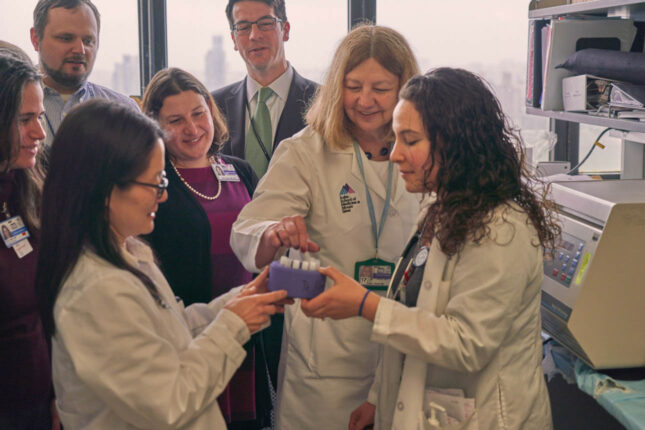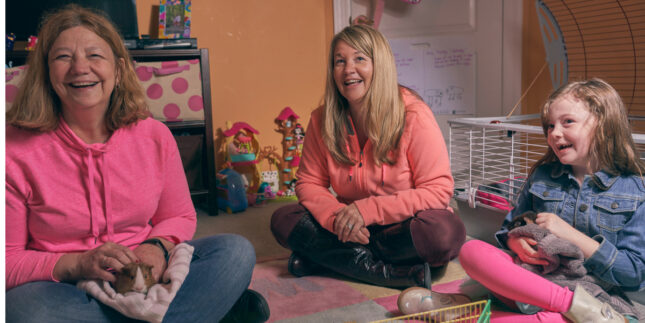Despite a history of unequal access to medical education, women have made a lasting impact on the world of medicine. The Infectious Diseases Society of America (IDSA) Foundation recently honored the lives and achievements of four women in medicine who have made a lasting impact on the field of infectious diseases (ID).

During the early 1970s, Judith A. Aberg, MD, FIDSA, FACP, was an unwed, teen mother to a newborn daughter. She and her boyfriend had to fend for themselves after each was asked to move out of their parents’ homes. They made a life for themselves in a humble, rundown duplex that sat on a large unmanaged property in Virginia Beach.
At the time, it seemed nearly impossible that she would end up in a career that put her at the center of efforts to solve a global medical crisis. Anyone who knows Dr. Aberg, though, knows that her determination, her steadfastness, her passion for medicine and for helping the underserved could not be deterred.
But it wasn’t easy. Raising a young child, the couple spent several years just trying to make ends meet, all while paying for their college tuition. Dr. Aberg worked as an attendant at an amusement park, caught and cleaned crabs to sell to restaurants, cleaned construction sites and mowed grass at convenience stores and gas stations. Along with friends, she and her boyfriend painted cars, replaced the engines, and resold them.
“We did all kinds of crazy things to earn money,” she said. Ultimately, she completed medical laboratory technology training at Virginia’s Norfolk General Hospital and was offered a position in microbiology immediately following graduation.
While family tensions were eased after the young couple married in 1976, life remained hard. Dr. Aberg supported the family, which at this point included two daughters, all while her husband attended dental school. Once he started his own dental practice, it was her turn. She started medical school, but her husband was far from supportive.
“Why don’t you just play tennis like the other wives?” he asked. Dr. Aberg remained undeterred, a trait she has exhibited throughout her life and career. Ultimately, they divorced, and he moved to Saudi Arabia.
Dr. Aberg credits her father for her decision to pursue medicine as well as her tenacity to get through medical school as a single mother. “My father was a healthy, active man in his 40s when he suffered post-operative paralysis resulting from complications during a back surgery. My family and I visited him daily for months in the hospital as he was recovering,” says Dr. Aberg. Her life as a typical young teen of 14 dramatically changed. Between visiting her father and studying, she spent a lot of time in the hospital, ultimately finding time to read to other patients.
For years, she blamed the surgeon for her father’s condition. “I thought to myself, ‘I can become a better doctor than that.’” Later, she concluded that the aspirin therapy her father was on was the likely trigger for his bad outcome. At the time, the connection between surgical bleeding and aspirin intake hadn’t been made.
“My father never gave up,” she said. “He suffered a complete sensory and partial motor paraplegia, but he was determined to walk again, which he did with the assistance of leg braces and walkers.” She says he also maintained a lifelong interest in electronics and mechanics. In his wheelchair, he would roll outside and coach neighbors on how to fix their cars. He never lost interest in his passions, nor did he give up on life despite the difficulties he faced. Neither did Dr. Aberg.
She graduated from the College of Medicine at Pennsylvania State University in 1990, completed her internal medicine residency from 1990 to 1993, and served as chief medical resident in 1993 at the Cleveland Clinic. She then served as a fellow in the Division of Infectious Diseases at Washington University School of Medicine from 1994 to 1996.
It was during her training she chose to focus on HIV/AIDS. It was the 90s. People, mostly young men her same age, were dying of AIDS. They were stigmatized and ostracized by society. That made her even more determined to help.
“I was going to stand up for them,” she said.
“These guys were sick, and even their parents
were alienating them.
Nobody deserves to get HIV.”
Originally envisioning a career in a basic science laboratory, Dr. Aberg credits her work with Richard Tenser, MD, MS, exploring immune modulating therapy for patients with multiple sclerosis, with shifting her focus to clinical and translational research. Later, Susan Rehm, MD, FIDSA, and Len Calabrese, DO, at Cleveland Clinic fueled her passion to provide care to patients as a clinical investigator.
Then she met William Powderly, MD, FIDSA, at Washington University. Bigger than life, Dr. Powderly could be intimidating to many, but she was struck that they shared the same passion and righteousness to improve the health outcomes of those with HIV by reversing the “bench-to-bedside” philosophy to “bedside-to-bench.” It was their clinical observations of metabolic derangements and co-morbidities occurring in younger patients with HIV that led them to develop clinical and translational investigations driving the basic scientists to determine the underlying pathogenesis of these HIV associated metabolic complications. Dr. Aberg developed her career using the infrastructure of the Division of Acquired Immunodeficiency Syndrome (DAIDS) supported AIDS Clinical Trials Group (ACTG).
She took a position as Assistant Professor and Co-Director of the AIDS Clinical Trial Unit at the University of California, San Francisco. There, she began to question why – if patients living with HIV were regaining immunity – the guidelines recommended these patients continue lifelong drug therapies for infections such as mycobacterium avium complex (MAC).
“Why keep treating them for MAC if their immune systems were reconstituting?” she asked. The drugs were making patients sick; there were proven dangers due to drug interactions, and there were high costs involved. “Some of my colleagues thought I was totally insane,” she said. “But the pill burden and side effects affected the quality of life so much for these patients.” She did the pilot study to prove she was right, followed by a larger ACTG study that she led and was further confirmed by others. Subsequently, the guidelines changed. “It was one of my earliest contributions,” she noted.
As persons with HIV continued to live longer, there was increased demand for primary care and preventative vaccines. Dr. Aberg led numerous studies exploring drug interactions, vaccine responses and management of co-morbidities, most notably her work in cardiovascular complications associated with HIV. Dr. Aberg has been instrumental in developing state and national guidelines for the care of persons with HIV and has served and currently serves on multiple guideline panels.
Now, as the Chief of the Division of Infectious Diseases, she has established five clinical research sites and has partnered with basic science, behavioral science and genomics colleagues with the goal of promoting research development throughout the Mount Sinai Health System. Dr. Aberg has always appreciated the ability of infectious diseases physicians to have a lasting and meaningful impact on their patients’ lives. “Even in the setting of HIV where there is no cure, persons with HIV are living full, productive and happier lives,” she said. “It’s very gratifying.”
She highlights parts of her career that she finds most rewarding, first, when a medical student makes his or her first diagnosis, and then knows how to treat that condition, and the other is when someone you’ve mentored is on stage for the first time or giving their first poster presentation. “It’s exciting to watch other people’s careers develop,” she said.

Harkening back to those challenging early days as a young teenage mother, Dr. Aberg encouraged her daughters to never allow others to dictate what they can achieve in life. “Dare to be yourself,” she told them. “You should be able to do anything you want to do.”
This article is adapted with permission of Infectious Diseases Society of America Foundation
Read about Women of ID: Changing the Face of Science & Medicine
Judy Aberg comments on the honor of being
recognized among women in ID.
The IDSA campaign on women was an incredible honor but it also had its own agenda. As we are currently in the midst of fellowship recruitment and about to embark on residency recruitment season, this is a good time to reflect on our own experiences.
I recall the day I interviewed at WUSM for fellowship quite well. Dr. Medoff asked me to meet with him first. He asked me if I decided not to come to WUSM for residency because of our interaction at that time. Quite frankly, I did not even recall but he reminded me quickly that he asked me why I would uproot my daughters to move to St. Louis. He told me that I responded saying that I was “sick and tired of people telling me what I can and cannot do”. He said that no one that junior ever spoke to him in that manner and not that I was rude but that his interpretation was that I was direct and focused. He hoped that I would come to WUSM. He then asked me where else I was applying to. I told him my three other choices and he thoughtfully went over my rationale (expertise in mycology) and why WUSM would be the best for my career. He spoke highly of his colleagues at each institution. Never once did he say anything objectionable about the other places.
My other major deciding factor was based on my experience at the annual IDSA meeting. There was a satellite symposium sponsored by Pfizer in which Bill Powderly was one of the prominent speakers. I was struck by how Bill got into a “discussion” with the other speakers and maybe not so politely told them that they had no data to back up their statements. Here he was being paid by a company yet maintained complete integrity. I decided then that I wanted to train at WUSM.
After we finish training, we all think that our residency and fellowship training were the best. I am grateful that I trained under the 2 attending system that alternated consults between a physician scientist and a clinician. Fortunately for my class, both Drs. Little and Medoff were clinicians and no longer doing bench research. There was no better moment than seeing Russ Little engage with a patient and clasp his hands saying “terrific” after you provided your differential diagnosis and management.
The IDSA women’s campaign missed the opportunity to discuss career development. This is such a key role all of us play. I have come to use the term “fitability” as the strongest criteria to select training programs and positions. One knows where they belong and if it is the right career opportunity for them. We can all describe it but it is difficult to have on a checklist. I invite those in all practice types and pharma to meet with the fellows to share why they chose the direction they did. As our program director at WUSM, Bill encouraged us to interview as a way to explore the various opportunities awaiting us. It was great advice. It reaffirmed what I wanted to do but also provided wonderful networking skills. In fact, I have maintained professional relationships and collaborations with individuals I met during those interviews including Melanie Thompson who had a private practice and is now Chair of the HIVMA. And it was actually during the annual ACTG meeting that Bill introduced me to Mark Jacobson who then offered me an outstanding opportunity at UCSF.
“Keep the doors open, there can be a wealth of opportunities on the other side.”
– Judith Aberg, MD